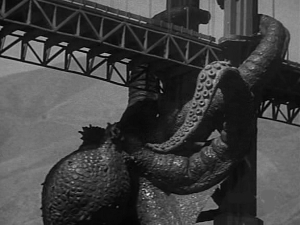
Columbia Pictures should give us all hope that we can rise above our station in life. This little Poverty Row studio, which made a name for itself producing comedy shorts in the 30s (including The Three Stooges’ most famous works) had, by the mid-50s, replaced RKO as a member of the Big Studios Club. With everything from Superman cartoons to Marlon Brando Oscar winners in their catalog, its seems only natural Columbia would try to field a giant monster movie for 1955.
You have to give them credit for going about it the right way – hiring two of Them!‘s writers and a man (now) more famous than either of ’em – the stop-motion animator behind The Beast from 20,000 Fathoms, Ray Harryhausen. If this film’s remembered for anything, it’s remembered for Harryhausen’s effects. This is the mid-point between his career-defining turn in Beast and the next year’s State of the Art showcase, Earth vs. The Flying Saucers. But Art doesn’t come cheap, so I shouldn’t be surprised all of Harryhausen’s contribution’s are crammed into the film’s last 15 minutes. I was. Unpleasantly so. But I shouldn’t have been.
It Came from Beneath the Sea fired its first warning shot right off, beginning with a Bad Movie Double Down: droning narration played over military stock footage. It’s 1955, after all, one year after the successful launch of the U.S. Navy’s first nuclear submarine, the U.S.S. Nautilus. This is meant to make the move Relevant to a distracted audience who may not give a crap about anything outside their pathetic little lives. It ends up pointing towards a theme that might’ve ameliorated the many failings of this film, had anyone cared to play that theme out. As Our Humble Narrator says,
“The mind of man had thought of everything – except that which was beyond his comprehension!”
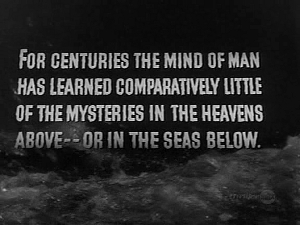
Given this is the 50s (and that we spend five minutes getting to know how much of this new sub is “beyond [the] comprehension” of your average sailor) and that most monster movies are powered by humanity’s neurotic attitude towards cutting edge technology, it would’ve been nice to explore that double-edged sword: for technology can be both scouring monster and soothing balm, under the right circumstances. Then again, I’m pretty much describing the original Godzilla, which wouldn’t come out in the U.S. until the next summer. Instead, after the credits rise from a boiling ocean and the music (by an uncredited Mischa Bakaleinikoff) does it’s best imitation of Henry Mancini’s work from Creature from the Black Lagoon we get another staple of the Classic Bad Movie – a Wall of Text, meant to set the mood with Solemn Statements like,
“Since the coming of the Atomic Age, man’s knowledge has so increased that any upheaval of nature would not be beyond his belief.”
I don’t know – once the giant octopus starts getting grabby with your ship questions of “belief” become pretty damn moot. So when a mysterious blob on the sonar interrupts their shakedown cruise by giving them a literal shakedown, Commander Mathews (Kenneth Tobey, last seen around here fighting The Thing From Another World) orders the U.S.S. Unnamed-In-This-Film-So-Just-Pretend-It’s-The-Nautilus back to Pearl Harbor. At least the damned thing’s still under warranty, though I’d love to see Commander Mathews explains this particular hit-and-swim to his COs.
At this point, even the casual monster fan should be saying, “Okay, I know where this is going. The 20,000 Leagues Under the Sea parallels are coming on hot and heavy, and why not? It’s a perfect thematic fit for this post-war Age of Paranoia. Two ocean-going, atomic-powered monsters – one ‘natural,’ one technological – duke it out to see whose cuisine shall reign supreme. I’m on board. C’mon, movie, hit me!”
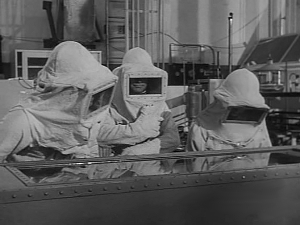
It did, striking a real low blow with its choice of focus. We’ve met Commander Mathews already, and spent ten good minutes getting to know him, his XO, Griff (Chuck Griffiths), and a few of the men under his command. Well, after the Not-Nautilus docks, Griff disappears – a shock to those of us whose ideal Commander/XO relationships come from Star Trek. Since we won’t return to the Not-Nautilus until the climax, and its crew will do nothing of any importance for the duration, that was ten minutes wasted on padding. The film could’ve started itself in Pearl, with that shot of three people examining a chunk of octopus above, and we would’ve lost nothing.
But, on the other hand, that would’ve forced us to spend more time with our three leads and their di-polar love triangle. Here’s where the real cracks in It‘s armor begin to appear. For once thing, Our Humble Narrator feels the need to speechify over the transition from sub to lab, and every other transition, too, just in case anyone in the audience Rip Van Winkled their way from 1900 and don’t know that, in a film, a cross-fade means “time has passed.”
“What was the nature of that nameless substance found caught in the damaged diving plains? A substance so strange, so inexplicable and alarming, that the best minds of the nation had to be called upon to solve the problem? Behind the guarded door, where the secret lay hidden, and for the first time in their lives, three people met.”
Wow, thanks for that oh-so-essential information. I certainly wouldn’t have gathered it from the next scene, where this film’s Commander meets his Scientist counterparts, Professor Lesley Joyce (Faith Domergue) and Dr….John Carter (Donald Curtis)…? At this point, my notes read, “Holy shit, this octopus is toast. No Jasoomian sea creature can stand against the Warlord of Mars!” Sadly, this John Carter turned out to be Of Harvard, not Mars. Dejected, I added John Carter vs. Giant Octopus to the pile of Better Movies This Could Have Been and focused on It‘s actual heroes.
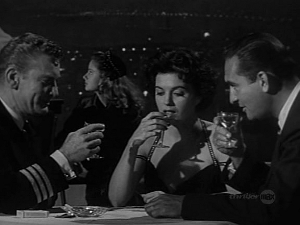
John Carter of Harvard is our Elder Scientist, despite not being that much older than his co-stars. Prof. Joyce is the same Lady Scientist archetype Joan Weldon played in Them!: all business from the start, she’s initially pissed at the Commander Mathew’s insistence on her presence. “Well,” she says, with as much haughtiness as possible, “I feel like I’m being drafted.” Commander Mathews – who tells us, through Joyce, that we can all call him “Pete” – puts the moves on early, dropping great lines like, “Uhh…for the record, are you tied up?” Prof. Joyce is having none of it. She’s only got eyes for Dr. Carter, “the inventor of analytically biology.” As opposed to…what? Synthetical biology? Chaotic biology? The half-assed, slap-dash biology practiced by medieval doctors and modern creationists?
Oh, what-the-fuck-ever. Carter can’t be a Warlord of Mars, but he has to found new, nonsensically named disciplines. Otherwise, he’d have no backstory whatever, and no character beyond The Elder Scientist Who Explains Everything to Us, the Dense-as-Dark-Matter Audience. Having Joyce around ameliorates this somewhat, since the two can tag team their expository speeches. But apart from that, Dr. Carter has nothing to do until the end, when he’ll prove more useful in an undersea fight, by virtue of being a main character, than a ship full of trained Naval officers.
Worse yet, John Carter of Harvard never seems to catch any of his hot young colleague’s lingering glances around the laboratory. He never once tries to out-alpha dog Commander Pete or call him on his cockblocking ways. He seems genuinely bemused by the two people he’s suddenly forced to work with, and the way they’re doing the Typical Hollywood Romance Dance. You know that number, right? Well, play it, Sam. You played it for her, you can play it for me. You start off at each other’s throats, twist to the left, twist to the right, stop a giant octopus attack on San Francisco, fall in love, The End.
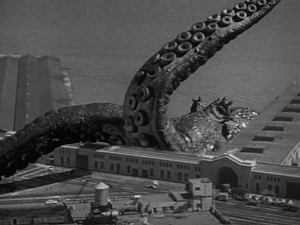
And that’s what it’s all about, unfortunately. The actual attack on San Francisco doesn’t begin until an hour into this hour and eighteen minute movie, long past the point where I gave up hope. The movie’s most famous sequence – where the octopus pulls down the Golden Gate Bridge – is a thin excuse to put our main characters in some jeopardy without getting them back into the submarine (forcing Carter and Mathews to run across the bridge, throw some switch, and escape before the bridge collapses). The boys still go back under da sea, but Prof. Joyce is stuck on land since women weren’t allowed on submarines in the mid-50s. Oh, she can spend the whole film designing a super torpedo that’ll punch through the octopus’ before it explodes, ensuring a clean kill…but having her there to push the button would’ve been disastrous for Navy morale…and the audience’s. Obviously.
The torpedo punches through with no problem, but It grabs the Not-Nautilus before detonation. (Commander Pete even says, “This is where we came in,” prefiguring Pink Floyd’s The Wall.) To free themselves, and grind the last five minutes of this movie to an absolute halt, Commander Pete and John Carter of Harvard engage in the least-interesting action you can have in any action movie: action scuba diving. They strap some C4 to the monster’s tentacle, free themselves, and blow It to hell before It can sent any more tentacles down Market Street. Beat Poets, Dharma Bums and proto-Hippies from the Palisades to Palo Alto no doubt united in mass celebration, scaring the shit out of this universe’s California Republican Party. Our Heroes unite for one last drink before going their separate ways and I join them in the hope excessive drinking will help me forget this movie’s existence.
Shame, since our three leads have genuine chemistry once they’re all around a dinner table and talking about something besides exposition. I could see them forming a Prof. Joyce sandwich once they worked through the inevitable squick…But seriously, these three are wasted in the most conflict-free love triangle this side of the Twilight saga.
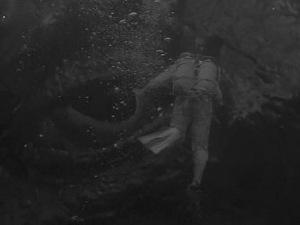
Faith Domergue is mid-50s B-movie royalty on the strength of her work from 1955 alone. Aside from this, she starred in Cult of the Cobra, The Atomic Man and (most famously) This Island Earth. She’s the second-best thing about this movie, coming in right on the octopus’ non-existent heels, and I don’t mean to call her a Bella Swan. She’s much better than that. In fact, she’s better than the rest of this movie. Don Curtis would go on to do…not great…but at least passable work in Earth vs. the Flying Saucers and I loved Kenneth Tobey in The Thing. As Thing protagonists go, I love Kenneth Tobey the way most people love Kurt Russell. But because I love The Thing from Another World I know there’s no reason for characters in a cheap sci-fi movie to be this bland. Or for the movie itself to be this boring.
Just goes to show actors – even the best of ’em – need a director with the style of, say, Them!‘s Gordon Douglas. And that director needed a script worth more than a fart in a wind. More time to shoot wouldn’t have hurt either – I’ve read they shot all the human bits in as little as nine days – but you can only polish a turd for so long. Thing is, this movie’s writers include the man who’d go on to take part in, not one, but two versions of Inherit the Wind – Harold “Hal” Smith – including the good one you’re all thinking of right now. Guess we know who whipped those – and the script for Them! – into shape, and their names aren’t Hal Smith, or George Worthing Yeats.
The other thing is, there’s nothing at stake here, the characters are never in real jeopardy (until the last five minutes) and who cares who Prof. Joyce hooks up with? She certainly doesn’t – bigger things are literally afloat. Like, oh, say, for example, the giant fucking cephalopod! If you want Human Drama in your monster movie you could at least tie it into the somewhat-larger-in-scale drama you set up by putting a giant octopus in your movie. Subplots should tie into the main premise, is all I’m sayin’, no matter how weird the premise might be. If they don’t, they feel like extraneous wastes of my time. It looks like the cast felt the same way about this job, regardless.
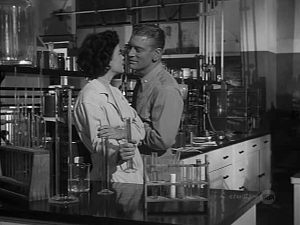
I’ll admit, there are some good, non-Harryhausen parts of this production. The way Prof. Joyce grabs a glass beaker while asking Commander Pete if he has “time for love” while “driving that submarine around” is darling, a great joke I’m sure everyone came up with on the spot to keep from hanging themselves out of boredom. As a man raised on Japanese giant monster movies of the 70s, I admired the film’s use of stock footage. Some of it (like the scenes of destroyer’s dropping depth charges) is downright cinematic. Black and white photography eases the transitions between the new footage and the Navy surplus, anyway, something that keeps better films (like the World War II films of the 70s) from being perfect, since they’re in color and color fades faster than anything, save for American’s knowledge of their own history.
The stock footage make this awful film (barely) bearable because it’s all the spectacle this production could afford, aside from fifteen minutes of stop motion at the end. Otherwise, this movie would be an hour-long parade of Tedious Meeting Scenes, which it virtually is already. This is the movie Ed Wood kept trying to make throughout the late-50s and early-60s, right down to the droning narration-for-its-own-sake.
At least the octopus is awesome, no matter its number of tentacles (six, to save money). The three second shot of a flamethrower squad fighting off one of those tentacles is even more awesome. But that’s less than a percent of this lame, half-hearted jump onto to Atomic Monster bandwagon. Great talents are often twisted for the service of bad work, and the same’s true here. Avoid It Came from Beneath the Sea, no matter how curious you might be about it. Everyone involved’s made better stuff, anyway.
![]()
![]()
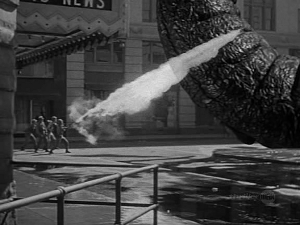

It’s not actually an octopus, since it only has six tentacles. It doesn’t have two stumps, either; it was born with six tentacles.
What, was I going to spend the entire review calling it a “sextopus”? That has way to many other connotations. And I don’t necessarily want the kind of visitors who would put that in their search terms.
(That said, you’re absolutely correct. That’s some missed comedic potential, right there.)
Sir,
as you’ve described,it sounds for all the world like an earlier version
of Emmerich’s “Godzilla”. Am I that far off?
Yes, though it did feature a two second clip of It during the initial chase scene, about an hour in (right before Godzilla roars at the two looters and flattens their car). But G98 was a two and a half hour slog through that one plot Emmerich uses for all his disaster movies: intellectual schlub chases girl who left his ass to get a better job and nevermind whether they’re bad for each other or not. It’s Independence Day v. 1.5 Beta, and there’s no need to look any further back than that. Mothra only knows why Emmerich chose to visually chest-bump this ol’ crapfest…though, knowing his taste, I’m tempted to think he actually likes this film with unironic sincerity.
Great review as always. I love these “classic” monster movies even when they’re crap.
Can you give us a planned list of reviews you’re going to tackle soon? I’m interested in what sort of things we can look forward to.
As am I. Believe me, when I know what my schedule’s like, everyone else will too.